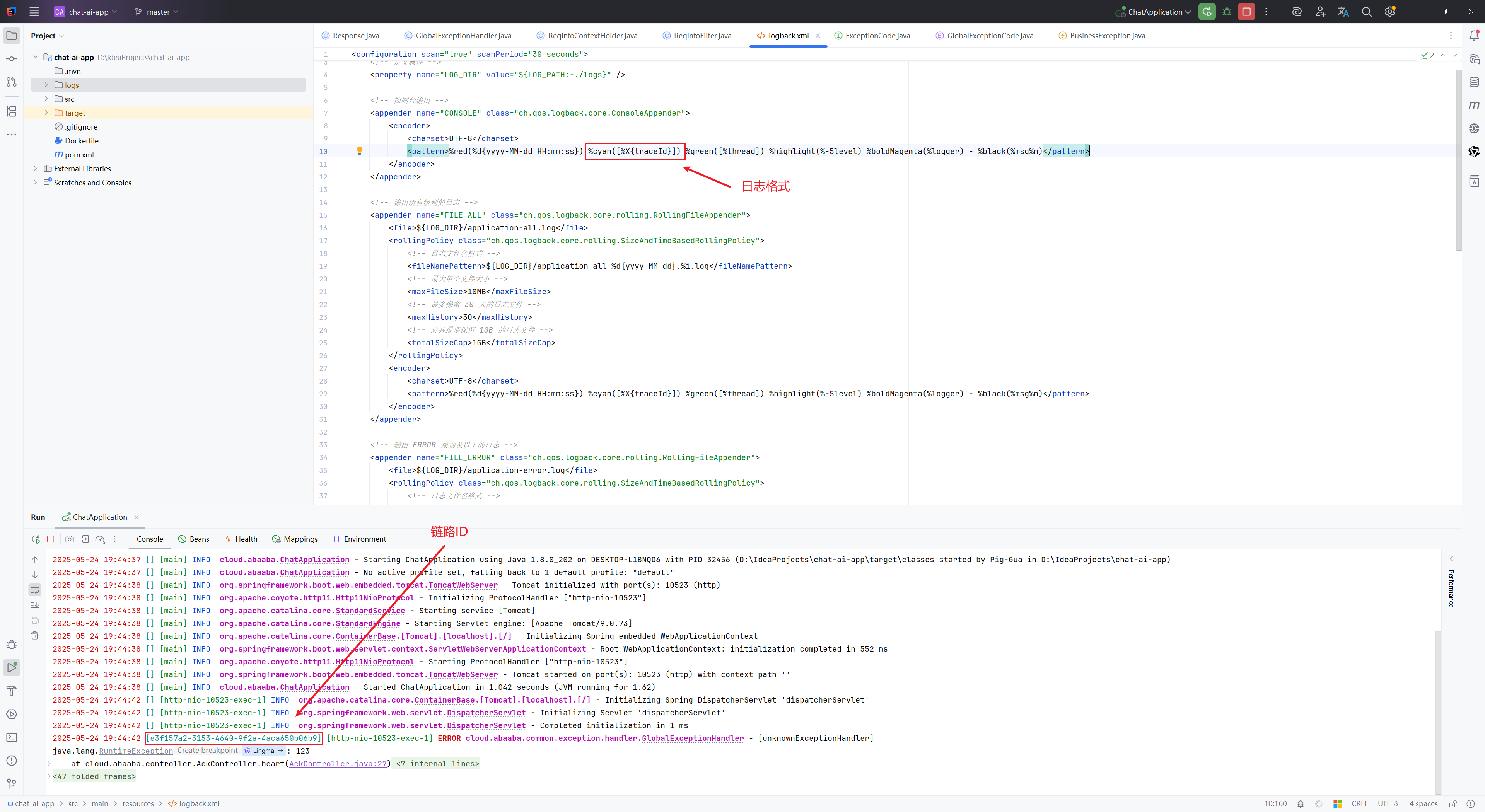后端框架搭建
全局统一响应
设计意义
统一的响应格式,方便前后端进行交互。前端可以在响应拦截时,统一根据异常码进行逻辑处理。
设计思路
首先需要确定响应Json格式,响应格式如下:
字段方面:
1、code码方便代码进行判断。数据类型String
2、msg用于前端页面展示信息。数据类String
3、data是返回的数据。数据类Object
其中code的数据类型为什么选String而不Integer 呢?主要是考虑代码规范,后续不同模块要设计错误码格式进行区分。例如,规定错误码统一为6位,1-2位代表服务,3-4位代表服务内的模块,5-6位用于模块内错误枚举序号。此时为了落地这种错误码设计,就可能会遇到:服务编号位0开头,整体错误码位数超出Integer范围,等情况。所以采String 类型比较好落地,避免不必要的麻烦。
{
code: "200",
msg: "请求成功",
data: {}
}其次需要了解如何实现全局响应:
首先是正常情况响应,通常是由Controller层代码手动返回数据的。对于这类情况,需要方便快速的对原始数据格式进行封装,然后返回。根据此思路,代码实现上,data字段采用泛型,提供静态方法快速构造通用响应。其中成功的情况分为,有数据成功和无数据成功。
@Data
public class Response<T> {
private String code;
private String msg;
private T data;
public static <T> Response<T> success() {
return Response.success(null);
}
public static <T> Response<T> success(T data) {
return Response.error(GlobalExceptionCode.SUCCESS, data);
}
public static <T> Response<T> error(ExceptionCode exceptionCode) {
return Response.error(exceptionCode, null);
}
public static <T> Response<T> error(ExceptionCode exceptionCode, T data) {
Response<T> result = new Response<>();
result.code = exceptionCode.getCode();
result.msg = exceptionCode.getMsg();
result.data = data;
return result;
}
}其次是异常情况响应,异常响应可以分两种,一种是代码逻辑进行的业务校验异常,一种是没有预料到的bug引发的代码异常。第一种情况通常不会去return异常,而是采用throw异常的方式进行抛出。第二种情况系统会自动throw抛出异常。所以需要进行全局的异常拦截,拦截到以后返回统一的响应格式。
全局异常处理
设计意义
避免异常信息直接返回给用户,体验不好,容易引发安全问题。
设计思路
1、设计异常框架体系。
首先是异常码,异常码必须包括code和msg,分别对应统一响应的code和msg。其次需要方便后续业务扩展。所以代码层面上采接口的方式去定义这个异常码。
public interface ExceptionCode {
/**
* 获取错误码
*
* @return 错误码
*/
String getCode();
/**
* 获取错误信息
*
* @return 错误信息
*/
String getMsg();
}后续每个业务模块实现此接口,扩展自己的异常码,为了方便,采枚举类型实现接口。
@Getter
@AllArgsConstructor
public enum GlobalExceptionCode implements ExceptionCode {
SUCCESS("200", "请求成功"),
UNKNOWN_ERROR("500", "未知错误");
/**
* 错误码
*/
private final String code;
/**
* 错误信息
*/
private final String msg;
}区分业务异常,和代码bug引发的异常,统一定义业务异常类,通过传入异常码进行构造。考虑后续一定会有异常信息,例用户名张三不存在这种需要采字符串模板结业务数据的提示,细节上采可变数组结匿名内部类的方式重getMsg方法,方便后续使用。
@Getter
public class BusinessException extends RuntimeException {
private final ExceptionCode exceptionCode;
public BusinessException(ExceptionCode exceptionCode, Object... args) {
this.exceptionCode = new ExceptionCode() {
@Override
public String getCode() {
return exceptionCode.getCode();
}
@Override
public String getMsg() {
return String.format(exceptionCode.getMsg(), args);
}
};
}
}2、全局异常拦截
首先需要了解Spring MVC流程架构,清楚异常拦截RestControllerAdvice的作用时机和范围。需要注意的是拦截器并不能拦截Filter中出现的异常,所以在拦截器中定义了一异常处理统一入口,供这类无法拦截到的地方调用。
@Slf4j
@RestControllerAdvice
public class GlobalExceptionHandler {
/**
* 用于处理全局异常拦截无法捕获到的位置
*
* @param ex 异常
* @param request 请求信息
* @return 通用返回
*/
public Response<?> handle(Throwable ex, HttpServletRequest request) {
if (ex instanceof BusinessException) {
return businessExceptionHandler((BusinessException) ex, request);
} else {
return unknownExceptionHandler(ex, request);
}
}
/**
* 业务异常
*/
@ExceptionHandler(BusinessException.class)
public Response<?> businessExceptionHandler(BusinessException ex, HttpServletRequest request) {
log.info("[businessExceptionHandler]: {}-{}", ex.getExceptionCode().getCode(), ex.getExceptionCode().getMsg());
return Response.error(ex.getExceptionCode());
}
/**
* 兜底处理
*/
@ExceptionHandler(Throwable.class)
public Response<?> unknownExceptionHandler(Throwable ex, HttpServletRequest request) {
log.error("[unknownExceptionHandler]", ex);
return Response.error(GlobalExceptionCode.UNKNOWN_ERROR);
}
}细节方面,业务异常都是代码中判断后抛出的业务校验信息,信息中会展示详细业务情况,通常不需要进行排查错误,所以采info日志级别。而兜底处理的情况,大多都是代码bug,所以需error级别方便后续服务器日志排查。
全局链路ID
设计意义
方面排查用户请求日志,尤其是分布式场景,需要在海量的日志中精准定位某一次请求的全部链路。
设计思路
如果请求头中有traceId,则继续采用。如果没有,需要新生成一个。如何记录全局链路ID,这里需要用到ThreadLocal,把请求信息放在ThreadLocal中。这里采用TTL方案,实现threadlocal线程传递。
public class ReqInfoContextHolder {
/**
* 跨线程传递ThreadLocal,详见 TL,ITL,TTL 区别
*/
private static final ThreadLocal<ReqInfo> CONTEXT = new TransmittableThreadLocal<>();
/**
* 创建空的请求上下文信息
*/
public static ReqInfo createEmptyContext() {
ReqInfo reqInfo = new ReqInfo();
CONTEXT.set(reqInfo);
return reqInfo;
}
/**
* 获取当前线程的请求上下文信息,若不存在则自动创建一个新的
*/
public static ReqInfo getReqInfo() {
ReqInfo reqInfo = CONTEXT.get();
if (reqInfo == null) {
reqInfo = new ReqInfo();
CONTEXT.set(reqInfo);
}
return reqInfo;
}
/**
* 清除当前线程的请求上下文,防止内存泄漏
*/
public static void clear() {
CONTEXT.remove();
}
}在最早的Filter中,生成并记录请求的traceId,记录请求信息上下文和日志MDC上下文中。需要注意结束finally清除上下文内容,避免内存泄漏。filter需要手动调用全局异常拦截器处理异常哈~
@Order(Integer.MIN_VALUE)
@Component
public class ReqInfoFilter extends OncePerRequestFilter {
@Resource
private GlobalExceptionHandler globalExceptionHandler;
@Override
protected void doFilterInternal(HttpServletRequest request, HttpServletResponse response, FilterChain filterChain) throws ServletException, IOException {
try {
// 创建新的请求上下文信息
ReqInfo reqInfo = ReqInfoContextHolder.createEmptyContext();
// 优先从请求头获取traceId,没有再随机生成
String traceId = request.getHeader("traceId");
traceId = StrUtil.isBlank(traceId) ? UUID.fastUUID().toString() : traceId;
reqInfo.setTraceId(traceId);
// 日志记录traceId
MDC.put("traceId", traceId);
// 放行
filterChain.doFilter(request, response);
} catch (Throwable ex) {
// 处理异常,写入响应
Response<?> errorResponse = globalExceptionHandler.handle(ex, request);
ServletUtils.writeJson(response, errorResponse);
} finally {
// 清理请求上下文信息,日志上下文信息
ReqInfoContextHolder.clear();
MDC.clear();
}
}
}日志打印出链路ID,需要配置logback日志格式,同时配一下日志路径,滚动策略,异步记录之类的。
<configuration scan="true" scanPeriod="30 seconds">
<!-- 定义属性 -->
<property name="LOG_DIR" value="${LOG_PATH:-./logs}" />
<!-- 控制台输出 -->
<appender name="CONSOLE" class="ch.qos.logback.core.ConsoleAppender">
<encoder>
<charset>UTF-8</charset>
<pattern>%red(%d{yyyy-MM-dd HH:mm:ss}) %cyan([%X{traceId}]) %green([%thread]) %highlight(%-5level) %boldMagenta(%logger) - %black(%msg%n)</pattern>
</encoder>
</appender>
<!-- 输出所有级别的日志 -->
<appender name="FILE_ALL" class="ch.qos.logback.core.rolling.RollingFileAppender">
<file>${LOG_DIR}/application-all.log</file>
<rollingPolicy class="ch.qos.logback.core.rolling.SizeAndTimeBasedRollingPolicy">
<!-- 日志文件名格式 -->
<fileNamePattern>${LOG_DIR}/application-all-%d{yyyy-MM-dd}.%i.log</fileNamePattern>
<!-- 最大单个文件大小 -->
<maxFileSize>10MB</maxFileSize>
<!-- 最多保留 30 天的日志文件 -->
<maxHistory>30</maxHistory>
<!-- 总共最多保留 1GB 的日志文件 -->
<totalSizeCap>1GB</totalSizeCap>
</rollingPolicy>
<encoder>
<charset>UTF-8</charset>
<pattern>%red(%d{yyyy-MM-dd HH:mm:ss}) %cyan([%X{traceId}]) %green([%thread]) %highlight(%-5level) %boldMagenta(%logger) - %black(%msg%n)</pattern>
</encoder>
</appender>
<!-- 输出 ERROR 级别及以上的日志 -->
<appender name="FILE_ERROR" class="ch.qos.logback.core.rolling.RollingFileAppender">
<file>${LOG_DIR}/application-error.log</file>
<rollingPolicy class="ch.qos.logback.core.rolling.SizeAndTimeBasedRollingPolicy">
<!-- 日志文件名格式 -->
<fileNamePattern>${LOG_DIR}/application-error-%d{yyyy-MM-dd}.%i.log</fileNamePattern>
<!-- 最大单个文件大小 -->
<maxFileSize>10MB</maxFileSize>
<!-- 最多保留 30 天的日志文件 -->
<maxHistory>30</maxHistory>
<!-- 总共最多保留 1GB 的日志文件 -->
<totalSizeCap>1GB</totalSizeCap>
</rollingPolicy>
<encoder>
<charset>UTF-8</charset>
<pattern>%red(%d{yyyy-MM-dd HH:mm:ss}) %cyan([%X{traceId}]) %green([%thread]) %highlight(%-5level) %boldMagenta(%logger) - %black(%msg%n)</pattern>
</encoder>
<filter class="ch.qos.logback.classic.filter.ThresholdFilter">
<level>ERROR</level>
</filter>
</appender>
<!-- 异步日志记录 -->
<appender name="ASYNC_FILE_ALL" class="ch.qos.logback.classic.AsyncAppender">
<appender-ref ref="FILE_ALL"/>
<queueSize>256</queueSize>
<discardingThreshold>0</discardingThreshold>
</appender>
<appender name="ASYNC_FILE_ERROR" class="ch.qos.logback.classic.AsyncAppender">
<appender-ref ref="FILE_ERROR"/>
<queueSize>256</queueSize>
<discardingThreshold>0</discardingThreshold>
</appender>
<!-- 根 logger 配置 -->
<root level="INFO">
<appender-ref ref="CONSOLE"/>
<appender-ref ref="ASYNC_FILE_ALL"/>
<appender-ref ref="ASYNC_FILE_ERROR"/>
</root>
<!-- 特定包的日志级别配置 -->
<logger name="com.yourcompany" level="DEBUG" additivity="false">
<appender-ref ref="CONSOLE" />
<appender-ref ref="ASYNC_FILE_ALL" />
<appender-ref ref="ASYNC_FILE_ERROR" />
</logger>
</configuration>可以看到,请求进入后,日志中带有统一traceId。

后续服务器排查错误,可以先查找error日志的traceId,然后定位该请求的全部日志。
c
cat application-all.log | grep e3f157a2-3153-4640-9f2a-4aca650b06b9前端框架搭建
Meesage(antd)全局调用封装
设计意义
通过查阅antd官方文档发现,Message组件推荐通过顶层注册的方式代替 message 静态方法,因为静态方法无法消费上下文,因而 ConfigProvider 的数据也不会生效。
设计思路
依据Message的Hooks使用方const [messageApi, contextHolder] = message.useMessage(); 其中api用于发起弹窗,context用于指定上下文。所以在全局调用message时,需要一个单例,需要导出api供全局调用,需要context在顶层注册。
1、构建message单例
import type {MessageInstance} from "antd/es/message/interface";
let message: MessageInstance | null = null;
export const setGlobalMesssage = (instance: MessageInstance) => {
message = instance;
}
export const getGlobalMessage = () => {
if (!message) {
throw new Error("message is not initialized")
}
return message;
}2、顶层注册+单例初始化
const [messageApi, contextHolder] = message.useMessage();
useEffect(() => {
setGlobalMesssage(messageApi)
}, [messageApi])
return <>{contextHolder}</>3、全局调用
getGlobalMessage().error({
content: '错误信息'
})axios请求封装
设计意义
发请求时需要处理token,收响应时需要处理错误码,所以需要做统一的请求响应拦截,减少重复代码逻辑,方便后续维护。
设计思路
需要对axios进行二次封装,现有的封装方式网上写的非常好的很多,这里做了些整合。
1、类型定义
import type {
Method,
AxiosError,
AxiosResponse,
AxiosRequestConfig
} from "axios";
/** 请求类型 */
export type RequestMethods = Extract<
Method,
"get" | "post" | "put" | "delete" | "patch" | "option" | "head"
>;
/** 错误类型 */
export interface HttpError extends AxiosError {
isCancelRequest?: boolean;
}
/** 响应类型 */
export interface HttpResponse extends AxiosResponse {
config: PureHttpRequestConfig;
}
/** 请求配置类型 */
export interface HttpRequestConfig extends AxiosRequestConfig {
beforeRequestCallback?: (request: PureHttpRequestConfig) => void;
beforeResponseCallback?: (response: PureHttpResponse) => void;
}
/** 统一响应类型 */
export interface Response<T> {
code: string;
msg: string;
data: T;
}
/** 导出 Http 请求方法 */
export default class Http {
request<T>(
method: RequestMethods,
url: string,
param?: AxiosRequestConfig,
axiosConfig?: PureHttpRequestConfig
): Promise<T>;
post<T, P>(
url: string,
params?: P,
config?: PureHttpRequestConfig
): Promise<T>;
get<T, P>(
url: string,
params?: P,
config?: PureHttpRequestConfig
): Promise<T>;
}2、axios实例封装:目前阶段还没有引入token相关逻辑,后续逻辑重点在请求拦截和响应拦截
import Axios, {
type AxiosInstance,
type AxiosRequestConfig, type AxiosResponse,
type CustomParamsSerializer
} from "axios";
import type {
HttpError,
RequestMethods,
HttpResponse,
HttpRequestConfig, Response
} from './type';
import {stringify} from "qs";
import NProgress from "../progress";
import {getGlobalMessage} from "../message";
// 相关配置请参考:www.axios-js.com/zh-cn/docs/#axios-request-config-1
const defaultConfig: AxiosRequestConfig = {
baseURL: import.meta.env.VITE_API_BASE_URL || '/api',
// 请求超时时间
timeout: 10000,
headers: {
Accept: "application/json, text/plain, */*",
"Content-Type": "application/json",
"X-Requested-With": "XMLHttpRequest"
},
// 数组格式参数序列化(https://github.com/axios/axios/issues/5142)
paramsSerializer: {
serialize: stringify as unknown as CustomParamsSerializer
}
};
class Http {
constructor() {
this.httpInterceptorsRequest();
this.httpInterceptorsResponse();
}
/** 初始化配置对象 */
private static initConfig: HttpRequestConfig = {};
/** 保存当前`Axios`实例对象 */
private static axiosInstance: AxiosInstance = Axios.create(defaultConfig);
/** 请求拦截 */
private httpInterceptorsRequest(): void {
Http.axiosInstance.interceptors.request.use(
// eslint-disable-next-line @typescript-eslint/no-explicit-any
async (config: HttpRequestConfig): Promise<any> => {
// 开启进度条动画
NProgress.start();
// 优先判断post/get等方法是否传入回调,否则执行初始化设置等回调
if (typeof config.beforeRequestCallback === "function") {
config.beforeRequestCallback(config);
return config;
}
if (Http.initConfig.beforeRequestCallback) {
Http.initConfig.beforeRequestCallback(config);
return config;
}
/** 请求白名单,放置一些不需要`token`的接口(通过设置请求白名单,防止`token`过期后再请求造成的死循环问题) */
const whiteList = ["/refresh-token", "/login"];
return whiteList.some(url => config.url?.endsWith(url))
? config
: new Promise(resolve => {
config.headers = config.headers ? config.headers : {};
config.headers["Authorization"] = "123456";
resolve(config);
});
},
error => {
return Promise.reject(error);
}
);
}
/** 响应拦截 */
private httpInterceptorsResponse(): void {
const instance = Http.axiosInstance;
instance.interceptors.response.use(
(response: HttpResponse) => {
const $config = response.config;
// 关闭进度条动画
NProgress.done();
// 业务逻辑错误统一处理
const {data} = response;
if (data.code !== "200") {
getGlobalMessage().error(data.msg)
return Promise.reject(data);
}
// 优先判断post/get等方法是否传入回调,否则执行初始化设置等回调
if (typeof $config.beforeResponseCallback === "function") {
$config.beforeResponseCallback(response);
return response as AxiosResponse;
}
if (Http.initConfig.beforeResponseCallback) {
Http.initConfig.beforeResponseCallback(response);
return response as AxiosResponse;
}
return response as AxiosResponse;
},
(error: HttpError) => {
const $error = error;
$error.isCancelRequest = Axios.isCancel($error);
// 关闭进度条动画
NProgress.done();
// 所有的响应异常 区分来源为取消请求/非取消请求
return Promise.reject($error);
}
);
}
/** 通用请求工具函数 */
public request<T>(
method: RequestMethods,
url: string,
param?: AxiosRequestConfig,
axiosConfig?: HttpRequestConfig
): Promise<Response<T>> {
const config = {
method,
url,
...param,
...axiosConfig
} as HttpRequestConfig;
// 单独处理自定义请求/响应回调
return new Promise((resolve, reject) => {
Http.axiosInstance
.request(config)
.then((response: AxiosResponse<Response<T>>) => {
resolve(response.data);
})
.catch(error => {
reject(error);
});
});
}
/** 单独抽离的`post`工具函数 */
public post<T, P>(
url: string,
params?: AxiosRequestConfig<P>,
config?: HttpRequestConfig
): Promise<Response<T>> {
return this.request<T>("post", url, params, config);
}
/** 单独抽离的`get`工具函数 */
public get<T, P>(
url: string,
params?: AxiosRequestConfig<P>,
config?: HttpRequestConfig
): Promise<Response<T>> {
return this.request<T>("get", url, params, config);
}
}
export const http = new Http();核心技术点
1、如何设计全局统一响应
2、请求进入后端的mvc流程
3、全局异常拦截的作用时机
4、ThreadLocal的原理及使用
5、TL,ITL,TTL的原理及区别
6、如何实现多线程/线程池上下文传递
7、logbak日志配置
8、线上环境如何排查错误


评论区